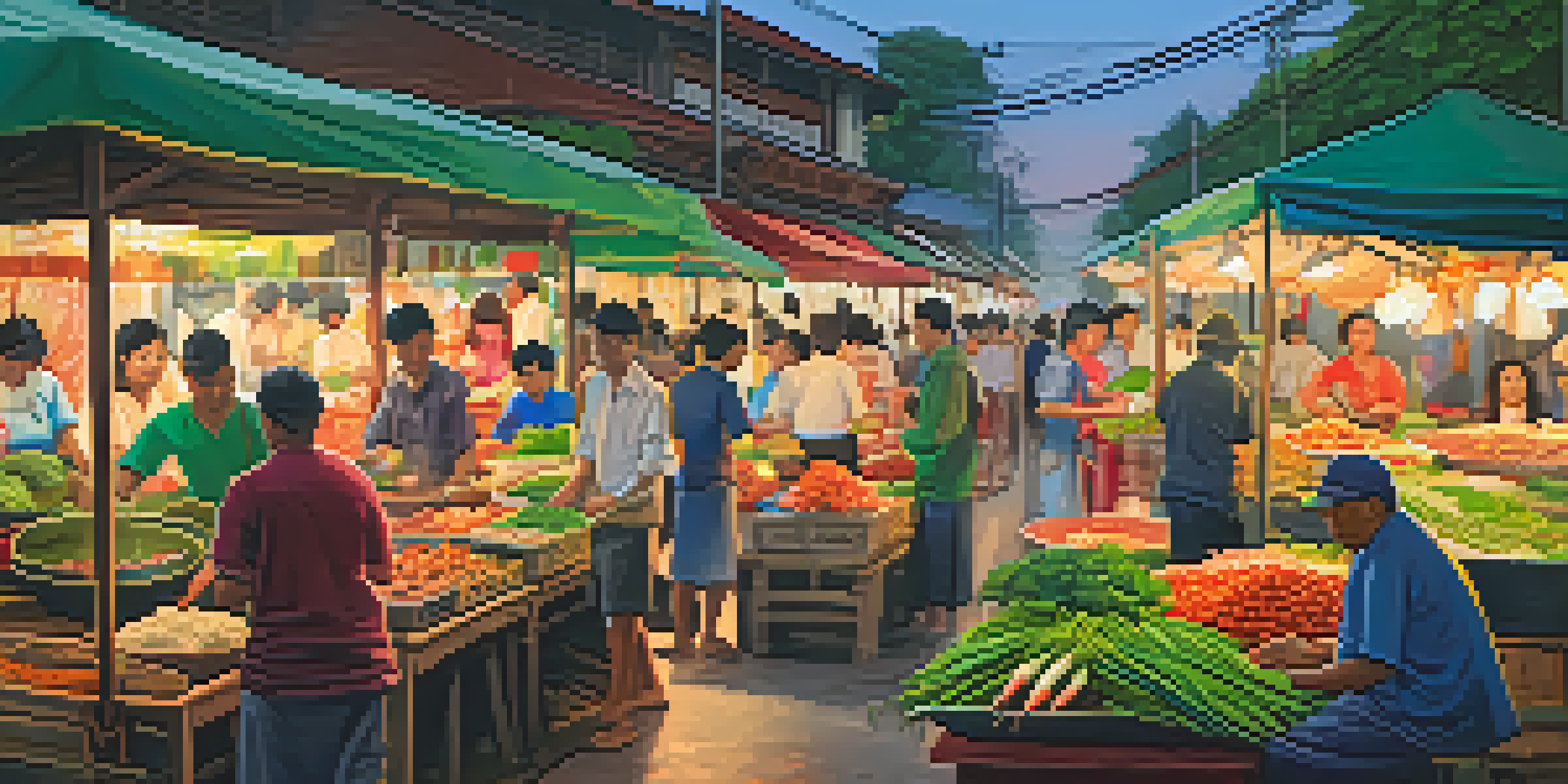Sustainable Dining: Eco-Friendly Culinary Tourism in Thailand

Understanding Sustainable Dining in Thailand
Sustainable dining marries culinary experiences with environmental consciousness. In Thailand, this approach is becoming increasingly popular among tourists who want to enjoy delicious food while being mindful of the planet. It's not just about eating; it's about making choices that promote local ecosystems and support communities.
Sustainable dining marries culinary experiences with environmental consciousness.
The Thai food scene is rich with flavors and traditions, but it also faces challenges like overfishing and deforestation. By opting for sustainable dining, visitors can help preserve the very essence of Thai culture while indulging in its vibrant culinary landscape. This shift reflects a growing awareness of how food choices impact local environments.
As travelers seek authentic experiences, sustainable dining emerges as a way to connect with local farmers, chefs, and artisans. This connection enriches the dining experience and fosters a sense of responsibility among tourists, making them partners in the journey toward a greener future.
Local Ingredients: The Heart of Thai Cuisine
One of the key pillars of sustainable dining is the use of local ingredients. In Thailand, many restaurants and street vendors source their produce directly from nearby farms, ensuring freshness and supporting the local economy. This emphasis on local sourcing not only enhances flavor but also reduces the carbon footprint associated with food transportation.

For example, you might find a dish made with organic vegetables from a community farm or seafood caught using sustainable fishing practices. By choosing these options, diners contribute to a system that values quality over quantity, promoting biodiversity and environmental health.
Local Ingredients Enhance Dining
Sustainable dining in Thailand emphasizes the use of local ingredients, supporting the economy and reducing carbon footprints.
Moreover, engaging with local farmers and learning about their practices can offer visitors a deeper understanding of Thai agricultural traditions. This connection to the land enriches the dining experience, turning each meal into a celebration of local culture and sustainability.
Culinary Tours: Connecting with Local Culture
Culinary tours are an exciting way to explore sustainable dining in Thailand. These tours often include visits to local markets, cooking classes, and tastings of traditional dishes prepared with eco-friendly ingredients. They provide a unique opportunity to learn about the cultural significance of food while supporting sustainable practices.
By prioritizing eco-friendly culinary experiences in Thailand, tourists can contribute to the preservation of local cultures and environments.
During these tours, participants can meet local chefs and food artisans who are passionate about preserving their culinary heritage. By engaging with these individuals, travelers gain insights into the recipes, techniques, and ingredients that make Thai cuisine so special, all while promoting sustainability.
Additionally, culinary tours often emphasize the importance of reducing waste. Many chefs share tips on how to minimize food waste in the kitchen, encouraging participants to adopt these practices at home. This knowledge can have a lasting impact, fostering a culture of sustainability beyond the dining experience.
Eco-Friendly Restaurants: Leading the Way
Thailand boasts a growing number of eco-friendly restaurants that prioritize sustainable practices. These establishments often implement measures like composting, using biodegradable packaging, and sourcing ingredients from organic farms. Dining at these restaurants not only supports their efforts but also raises awareness about the importance of sustainability in the food industry.
For instance, some restaurants offer plant-based menus that highlight the flavors of Thai cuisine while reducing the environmental impact associated with meat production. This approach appeals to both vegans and meat-lovers alike, showcasing the versatility and richness of Thai ingredients.
Culinary Tours Foster Cultural Ties
Culinary tours offer travelers a chance to engage with local chefs and learn about sustainable practices while exploring Thai cuisine.
Moreover, many eco-friendly restaurants engage in community initiatives, such as hosting workshops on sustainable cooking or supporting local artisans. By dining at these venues, tourists contribute to a larger movement that champions responsible tourism and community empowerment.
The Role of Traditional Cooking Techniques
Traditional cooking techniques play a significant role in sustainable dining in Thailand. Methods like steaming, grilling, and fermenting not only preserve the nutritional value of ingredients but also reduce the need for excessive oil or energy. These time-honored practices are often more environmentally friendly and reflect a deep respect for the ingredients used.
For example, the art of fermenting vegetables is not only a way to enhance flavors but also a method of food preservation that minimizes waste. Many Thai households have used fermentation for generations, and this practice is being celebrated in modern restaurants focused on sustainability.
By embracing these techniques, chefs can create dishes that are both delicious and environmentally conscious. This commitment to traditional methods helps keep culinary heritage alive while promoting a sustainable approach to dining.
Food Waste: A Growing Concern in Culinary Tourism
Food waste is a pressing issue in the global food system, and Thailand is no exception. In culinary tourism, it's crucial to address this concern by adopting practices that minimize waste. Many restaurants and food vendors in Thailand are now implementing strategies to reduce food waste, which can inspire tourists to do the same.
For instance, some establishments have begun donating excess food to local charities or composting organic scraps. These efforts not only help feed those in need but also promote environmental sustainability by diverting waste from landfills.
Combatting Food Waste is Essential
Addressing food waste through mindful practices is crucial for sustainable dining and encourages responsible tourism in Thailand.
Tourists can also play a role in reducing food waste by being mindful of portion sizes and sharing dishes. This not only enhances the dining experience but also encourages a culture of sustainability, where every bite counts.
Sustainable Dining: A Path to Responsible Tourism
Sustainable dining reflects a broader movement towards responsible tourism, where travelers seek to leave a positive impact on the destinations they visit. By prioritizing eco-friendly culinary experiences in Thailand, tourists can contribute to the preservation of local cultures and environments. This shift in mindset encourages a deeper connection between visitors and the places they explore.
As awareness of sustainability grows, more travelers are actively seeking out experiences that align with their values. Whether it's dining at eco-conscious restaurants or participating in culinary tours, these choices help promote a tourism model that benefits both guests and the local community.

Ultimately, embracing sustainable dining allows for a richer travel experience, where each meal becomes a celebration of local flavors and cultures. It’s a way for tourists to enjoy Thailand's culinary treasures while supporting the health of the planet and its people.